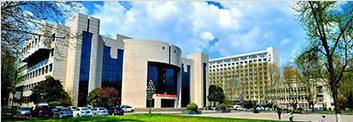报告题目:Turning Images into Knowledge: Computational Image Analysis and Quantitative Imaging Informatics
报告人:Dr. YU Weimiao
讲座时间:2018年6月7日(星期四)上午10:30-11:30
讲座地点:友谊校区老图书馆401室
邀请人:杨慧
报告简介:
The past decades have seen a rapid development of different bioimaging techniques. With these hardware advancements and the generation of novel probes, we are now able to acquire 2D images or 3D videos of migrating cell in vivo or in vitro. It seems that the development of microscopy techniques is faster than our ability of interrogating those acquired images. Qualitative "seeing" is the first step towards biological discoveries, since biological images/videos contain a wealth of quantitative information, which can only be revealed with considerable computational effort. Direct application of existing image processing and computer vision techniques to new biological problems is challenging and difficult. Nowadays, biologists, clinicians and computer scientists are closely working together to obtain new biological understanding, yet the complexities of biological/medical images/videos still pose many difficult problems. Solving these problems timely facilitates complex, systematic studies for biologists, as the developed approaches can extract information that reveal previously undetected phenomena, gaining us a deeper insight.
My research focused on using computational image analysis and quantitative imaging informatics as a powerful tool to facilitate the biological studies. We are transforming modern biology from qualitative observation to a quantitative science. With improved analysis capabilities, we will be able to extract reliable quantitative knowledge from vivid images/videos. Our research will have an impact on different biological fields, such as cell biology, developmental biology, cancer studies, stem cell research, drug discovery, clinical pathology and mechanobiology. In this sharing session, I will share how computational image analysis can help us to better understanding of different biological projects. We will first share a few projects on cell migration, including Quantitative Understanding of Cell Protrusion during Cell Migration, Collective Cell Migration in Drosophila Oocyte, Reconstruction of Zebrafish Embryo, etc. The 3D histology stack reconstruction will also be briefly discussed in the context of mouse HCC treatment. The collagen quantification using SHG imaging technical will be presented. The prognosis value of collagen for TNBC patient will demonstrated. I hope I can also cover another two projects on Liver Anti-fibrosis drug validation and skin disease classification.
报告人简介
Dr. Yu obtained his Ph.D from National University of Singapore (NUS) in 2007, majoring in image processing and machine vision. After working as a postdoc research fellow in Imaging Informatics Division of Bioinformatics Institute (BII) for 3.5 years, he moved to Central Imaging Facility of Institute of Molecular and Cell Biology (IMCB) in 2010. In IMCB, he was later promoted as Senior Postdoc Research Fellow, Research Scientist, Senior Research Scientist and Group Lead. He is currently heading a team, Computational Bioimage Analysis (CBA) Unit, to deepen and extend the R&D with clinical and industrial partners/collaborators. Driven by curiosity and passion, his team is keen to develop bioimage analysis and informatics solutions, including High-throughput Screening (HTS) and High Content Screening (HCS), analysis of histology image/stacks in 2D/3D, including IHC/IF/Multiplex images, and other general bioimage quantification methods. His research interests are Computational Bio-image Analysis and Quantitative Imaging Informatics. The goals are to develop analysis algorithms/software packages to quantify in details of the cell behaviours and tissue phenotypes under different conditions, the concentration/colocalization proteins, and other relevant information for a better biological, biophysical and physiology understanding of complex cell behaviour. His research integrates methodologies from multiple fields, such as signal processing, image processing and computer vision, optimisation, machine learning, pattern recognition, mathematical modelling, etc. His research outcomes were published in Current Biology, BMC Biology, Plos Generic, Bioinformatics, Nature Material, Nature Communication and Nature Cell Biology, etc. To enhance the application of machine learning and AI in clinical diagnosis/prognosis, he founded a biotech company, known A!maginostic Pte. Lte.




 betway必威西汉姆联官网
betway必威西汉姆联官网
 betway必威西汉姆联官网
betway必威西汉姆联官网